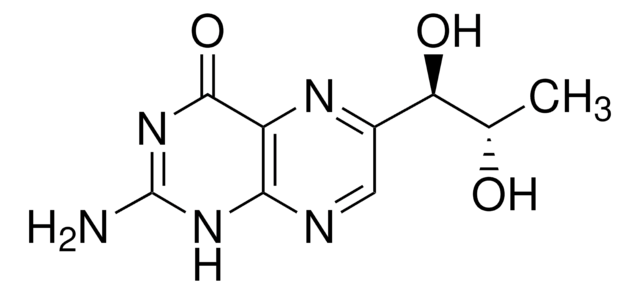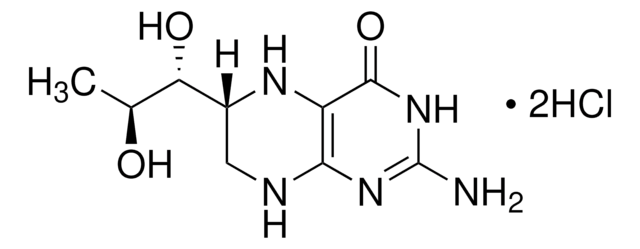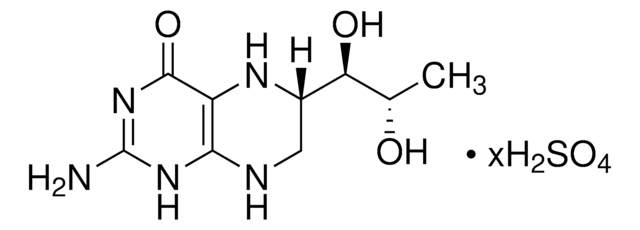37272
7,8-Dihydro-L-biopterin
≥94% (HPLC)
Synonym(e):
2-amino-6-(1,2-dihydroxypropyl)-7,8-dihydro-3H-pteridin-4-one
About This Item
Empfohlene Produkte
Assay
≥94% (HPLC)
Lagertemp.
−20°C
SMILES String
C[C@@H](O)[C@@H](O)C1=NC2=C(NC1)N=C(N)NC2=O
InChI
1S/C9H13N5O3/c1-3(15)6(16)4-2-11-7-5(12-4)8(17)14-9(10)13-7/h3,6,15-16H,2H2,1H3,(H4,10,11,13,14,17)/t3-,6-/m1/s1
InChIKey
FEMXZDUTFRTWPE-AWFVSMACSA-N
Anwendung
- A Landscape of Metabonomics for Intermingled Phlegm and Blood Stasis and Its Concurrent Syndromes in Stable Angina Pectoris of Coronary Heart Disease.: This study by Zheng et al. (2022) explores the metabolic profiles associated with phlegm and blood stasis syndromes in patients with stable angina pectoris. The research highlights the role of various metabolites, including 7,8-Dihydro-ʟ-biopterin, in the pathophysiology of these syndromes, suggesting potential diagnostic and therapeutic targets (Zheng et al., 2022).
- Three-dimensional structure of human tryptophan hydroxylase and its implications for the biosynthesis of the neurotransmitters serotonin and melatonin.: Wang et al. (2002) present the crystal structure of human tryptophan hydroxylase, providing detailed insights into the enzyme′s interaction with cofactors such as 7,8-Dihydro-ʟ-biopterin. This structural information is crucial for developing drugs targeting neurotransmitter biosynthesis pathways (Wang et al., 2002).
Lagerklassenschlüssel
11 - Combustible Solids
WGK
WGK 3
Flammpunkt (°F)
Not applicable
Flammpunkt (°C)
Not applicable
Persönliche Schutzausrüstung
Eyeshields, Gloves, type N95 (US)
Analysenzertifikate (COA)
Suchen Sie nach Analysenzertifikate (COA), indem Sie die Lot-/Chargennummer des Produkts eingeben. Lot- und Chargennummern sind auf dem Produktetikett hinter den Wörtern ‘Lot’ oder ‘Batch’ (Lot oder Charge) zu finden.
Besitzen Sie dieses Produkt bereits?
In der Dokumentenbibliothek finden Sie die Dokumentation zu den Produkten, die Sie kürzlich erworben haben.
Kunden haben sich ebenfalls angesehen
Unser Team von Wissenschaftlern verfügt über Erfahrung in allen Forschungsbereichen einschließlich Life Science, Materialwissenschaften, chemischer Synthese, Chromatographie, Analytik und vielen mehr..
Setzen Sie sich mit dem technischen Dienst in Verbindung.















